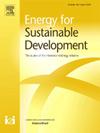温室气体排放强度分析。案例研究:采用热电联产和部分二氧化碳回收技术的生物乙醇厂
IF 4.4
2区 工程技术
Q2 ENERGY & FUELS
引用次数: 0
摘要
本研究评估了阿根廷科尔多瓦一家玉米生物乙醇工厂生产的无水乙醇的温室气体(GHG)排放强度。该厂采用了先进的技术,如通过蒸汽轮机进行热电联产和部分二氧化碳回收用于食品级用途,从而大大减少了生产过程中的碳足迹。计算得出的排放强度为 27.57 gCO2e/MJ,与欧洲指令 RED II 基准(30.3-67.8 gCO2e/MJ)相比处于较低水平。敏感性分析表明,如果没有二氧化碳回收,排放量将为 30.92 gCO2e/MJ,而 50% 的回收率可将排放量降至 17.92 gCO2e/MJ,100% 的回收率可将排放量降至 4.93 gCO2e/MJ。这些发现强调了二氧化碳回收技术在生物乙醇生产中最大限度减少排放的有效性。此外,该研究还探讨了在阿根廷实施经济激励措施以推广碳捕集与封存 (CCS) 技术的潜力。研究提出了减税、国家清洁能源基金、优惠融资和创建碳市场等激励措施,以支持碳捕集与封存技术的采用。通过整合这些措施,阿根廷可以显著提高生物乙醇生产的可持续性,减少温室气体排放,并吸引清洁技术投资。研究结果为今后的比较提供了一个基准,并强调了不断进行技术创新以提高生物燃料环保性能的重要性。本文章由计算机程序翻译,如有差异,请以英文原文为准。
GHG emissions intensity analysis. Case study: Bioethanol plant with cogeneration and partial CO2 recovery
This study evaluates the greenhouse gas (GHG) emission intensity of anhydrous ethanol produced in a corn bioethanol plant located in Córdoba, Argentina. The plant integrates advanced technologies such as cogeneration through a steam turbine and partial CO2 recovery for food-grade use, which significantly reduce the carbon footprint of the production process. The calculated emission intensity is 27.57 gCO2e/MJ, placing it in the lower range compared to the European Directive RED II benchmark (30.3–67.8 gCO2e/MJ). Sensitivity analysis shows that without CO2 recovery, emissions would be 30.92 gCO2e/MJ, while a 50 % recovery reduces emissions to 17.92 gCO2e/MJ, and a 100 % recovery could achieve as low as 4.93 gCO2e/MJ. These findings emphasize the effectiveness of CO2 recovery technologies in minimizing emissions in bioethanol production. Additionally, the study explores the potential of implementing economic incentives to promote carbon capture and storage (CCS) technologies in Argentina. Incentives such as tax deductions, a National Clean Energy Fund, preferential financing, and the creation of a carbon market are proposed to support CCS adoption. By integrating these measures, Argentina could significantly enhance the sustainability of its bioethanol production, reduce GHG emissions, and attract investments in clean technologies. The results provide a benchmark for future comparisons and underscore the importance of continuous technological innovation to improve the environmental performance of biofuels.
求助全文
通过发布文献求助,成功后即可免费获取论文全文。
去求助
来源期刊

Energy for Sustainable Development
ENERGY & FUELS-ENERGY & FUELS
CiteScore
8.10
自引率
9.10%
发文量
187
审稿时长
6-12 weeks
期刊介绍:
Published on behalf of the International Energy Initiative, Energy for Sustainable Development is the journal for decision makers, managers, consultants, policy makers, planners and researchers in both government and non-government organizations. It publishes original research and reviews about energy in developing countries, sustainable development, energy resources, technologies, policies and interactions.
 求助内容:
求助内容: 应助结果提醒方式:
应助结果提醒方式:


